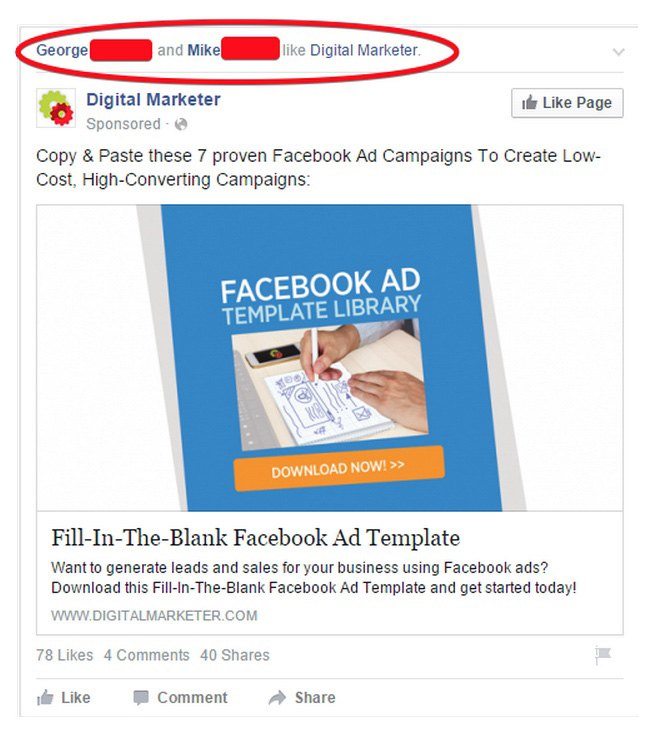Businesses still don’t believe Facebook advertising is worth the investment.
At least, that’s one takeaway from a new survey of 540 small business owners.
Those respondents would be surprised to find out that Facebook is on track to pull in $16.3 billion in global ad revenue this year, after seeing a 25% increase in advertisers on the platform since February 2015.
Now over 2.5 million people use Facebook advertising to reach their customers on social media. Here are four reasons you should join them.
1. Facebook advertising is laser-focused
With seemingly endless demographics, behaviors, and interests, the most powerful feature of Facebook’s advertising platform is by far its targeting capabilities – the ones they’re able to provide as a result of their mountain of user data.
Some of those targeting options include:
- Location
- Education
- Work
- Financial status
- Generation
- Parental status
- Ethnicity
- Languages
- Connections to specific Facebook pages
- Behaviors
And maybe more impressive than all the user data they have on one-fifth of the world, is how they got it in the first place.
When you “liked” the Boston Red Sox on Facebook, they added that to their pool of data.
When you shared that “Harry Potter and the Sorcerer’s Stone” was one of your favorite books, they added that to their data pool, too.
When you posted that status update to announce your engagement, they stored that as well.
The bottom line is this: Every time you “like” a page, interact with a post, or fill out another part of your profile, you voluntarily submit data to Facebook they make available to advertisers.
It is safe to assume that almost every Facebook action you take is being stored and used by businesses to serve you targeted advertisements. That’s how the social media giant has been able to amass the majority of its data.
Let’s take a peek inside Facebook’s Power Editor tool to see how targeted we can get our ads:

For the ad set above, I’m targeting 25-30 year-old liberal, divorced, doctorate-holding, female General Motors mechanical technicians, who studied mechanical engineering at Harvard between 2008 and 2012, who have a child between 1 and 2 years old, own a Lincoln, speak English, are interested in XBOX or Microsoft, and are traveling within a 25-mile radius of Boston, Massachusetts.
Whew. Try saying all of that in one breath!
Now, would I ever want to get that specific? Probably not. As you can see above, my potential reach is only 20 people. I just wanted to give you an idea of how focused you could get with Facebook’s targeting tools.
Use them wisely, and remember – even the most targeted ad won’t be successful if you don’t create a dedicated social media post-click landing page for it.
2. You can potentially reach one-fifth of the world
If “everybody’s doing it” was ever a good reason to get involved in something, this is it.
With 1.49 billion monthly active users, more than one-fifth of the entire world is on Facebook. That means when you add up every member of Twitter, Instagram, Pinterest, and LinkedIn, Facebook users still outnumber them all by more than 300 million.
Consider some of these other surprising statistics…
- 72% of online US adults visit Facebook at least once per month
- 968 million people use Facebook every day
- Users spend 20+ minutes on Facebook per day
- Facebook receives 1 trillion page views per month
- 11 million people use Facebook every 18 minutes
- Facebook adds 7,246 users every 15 minutes and 8 users per second
- Facebook has “Super Bowl reach” on mobile every day
There’s no question that there are people interested in your business on Facebook. All you need to do is find them.
3. Facebook has buying decision influence
Social media guru Jeff Bullas reported last year that a whopping 47% of Americans say Facebook is their number 1 influencer of purchases. That statistic is in line with other research that shows…
- 4 in 10 social media users have bought a product after “liking” or favoriting on Facebook, Twitter, or Pinterest
- Facebook leads the way as the network with the highest effect on purchasing decisions, with 30.8% of consumers saying it influences them more than any other platform
- Facebook is the most effective platform to get consumers talking about products
- 71% of people are more likely to purchase something based on a social media referral
- 81% of consumers say that posts from friends directly influence their buying decisions
- 38% of moms are more apt to purchase from brands that other women “like” on Facebook.
Facebook is able to guide our purchasing decisions because it has “social proof” on its side.
We value the opinions of our friends and family when it comes to making a decision to buy a product or spend money on a service. Facebook knows this, and they leverage social proof in their ads whenever possible.
Take a look how Facebook tries to get me to click on this ad for Digital Marketer’s Facebook Ad Template:

In the red circle, you’ll see I’ve been presented with a kind of social referral on behalf of two friends, and small business owners, who happen to like the product that’s being advertised. I say “kind of” because my friends George & Mike are not actually referring me to the product. Facebook is letting me know they “like” the page for that product – making it more likely that I’ll check it out.
4. Facebook ads’ remarketing potential
When Facebook’s ad platform was first introduced, you could spend hours narrowing your audience with countless demographics, interests, behaviors, etc. However, you were limited to showing ads to the people who found your brand through Facebook.
This was a problem for many brands because they couldn’t serve ads to some of their most qualified audiences – website visitors and email subscribers.
That all changed when Facebook introduced “Website Custom Audiences” and “Lookalike Audiences.”
Now, by simply copying and pasting a snippet of HTML code (called a pixel) onto specific pages of your website, you can target people who visit those pages with Facebook ads.
For example, I personally do not “like” Amazon’s brand page on Facebook. That means their updates won’t appear organically in my news feed at all.
I have, however, recently shopped Amazon for a Kindle.
Amazon makes use of website custom audience pixels because when I logged back into Facebook, I saw this ad in the sidebar:

That’s the exact model I was looking at but didn’t end up buying.
This technique can be used for any type of product or service. Creating a Website Custom Audience for people who abandon your post-click landing page, while excluding those who made it to your “thank you” page, is a great way boost conversions.
With Lookalike Audiences, you can target your email subscribers on the social network. Or, let Facebook’s algorithm generate a target audience similar to those subscribers by uploading a list of email addresses.
Both methods of remarketing have proven to be very effective.
When Banana Republic and Secret Escapes’ marketing teams employed the use of Lookalike Audiences, they saw a 60% and 134% boost in ad click-through rate, respectively.
Jon Loomer used website Custom Audiences to get email sign-ups at 2 cents apiece, and one online retailer reported seeing a 3200% ROI with the help of Custom Audiences.
Will you use Facebook advertising?
By adding a half million paying brands in the last year, Facebook has seen a 43% increase in ad revenue. Clearly at least some businesses are starting to believe in Facebook advertising. Are you one of them, or still hesitant to invest in the platform?
Get started creating your ads with the most comprehensive resource for Facebook ads and targeting with this free guide.
